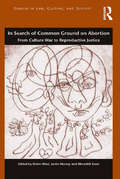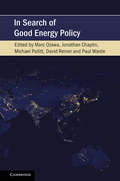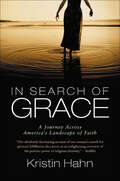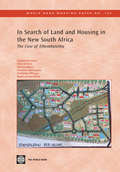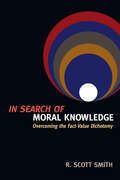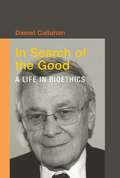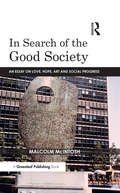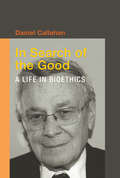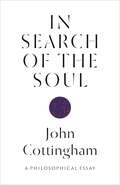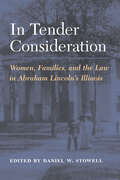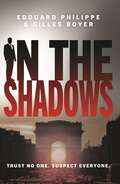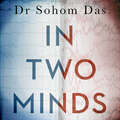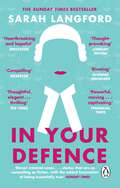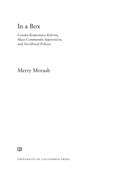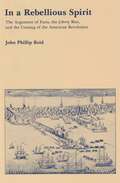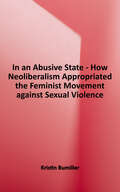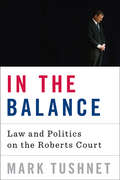- Table View
- List View
In Search of Common Ground on Abortion: From Culture War to Reproductive Justice (Gender in Law, Culture, and Society)
by Robin West Justin Murray Meredith EsserThis book brings together academics, legal practitioners and activists with a wide range of pro-choice, pro-life and other views to explore the possibilities for cultural, philosophical, moral and political common ground on the subjects of abortion and reproductive justice more generally. It aims to rethink polarized positions on sexuality, morality, religion and law, in relation to abortion, as a way of laying the groundwork for productive and collaborative dialogue. Edited by a leading figure on gender issues and emerging voices in the quest for reproductive justice - a broad concept that encompasses the interests of men, women and children alike - the contributions both search for 'common ground' between opposing positions in our struggles around abortion, and seek to bring balance to these contentious debates. The book will be valuable to anyone interested in law and society, gender and religious studies and philosophy and theory of law.
In Search of Good Energy Policy (Cambridge Studies on Environment, Energy and Natural Resources Governance)
by Paul Warde Jonathan Chaplin Marc Ozawa Michael Pollitt David ReinerDrawing on political science, economics, philosophy, theology, social anthropology, history, management studies, law, and other subject areas, In Search of Good Energy Policy brings together leading academics from across the social sciences and humanities to offer an innovative look at why science and technology, and the type of quantification they champion, cannot alone meet the needs of energy policy making in the future. Featuring world-class researchers from the University of Cambridge and other leading universities around the world, this innovative book presents an interdisciplinary dialogue in which scientists and practitioners reach across institutional divides to offer their perspectives on the relevance of multi-disciplinary research for 'real world' application. This work should be read by anyone interested in understanding how multidisciplinary research and collaboration is essential to crafting good energy policy.
In Search of Grace: A Journey Across America's Landscape of Faith
by Kristin HahnAfter years as a Hollywood writer and filmmaker, Kristin Hahn felt a crisis of faith: she had no spiritual group she could call her own. Setting out on a three-year journey, she began an investigation of America's religious traditions, practices, and beliefs.Crisscrossing the nation, Hahn spent a week cloistered in prayer with convent nuns and a month of Ramadan fasting with Muslims. She went door-to-door with young Mormon missionaries and head-to-head with turbaned Sikh yogis. She sat through marathon meditations with Buddhist masters and spent days in conversation and ceremony with an 0jibwe medicine man. Her explorations exposed her to the rich, ancient culture of the Jews and brought her into the enclaves of Christian Scientists and Amish farmers, as well as the less traditional realms of Scientology, neopagan witchcraft, and the congregations of new-age gurus.And this was only the beginning.Openhearted, humorous, and always thoughtful, In Search of Grace offers nourishment for our spiritual hunger -- and a myriad of ways to find a religious home.
In Search of Land and Housing in the New South Africa: The Case of Ethembalethu
by Stephen Berrisford Ntombini Marrengane Zimkhitha Mhlanga Michael Kihato Rogier van den Brink Dave DegrootThis study outlines the difficulties poor communities face in accessing peri-urban land in South Africa that could have implications and lessons for similar communities in other countries facing spatial segregation issues. 'In Search of Land and Housing in the New South Africa' focused on one community, composed largely of laid-off farm workers that wanted to buy their own farm in a peri-urban area west of Johannesburg. Their dream was to establish a mixed-use settlement. They wanted to call the village Ethambalethu-'Our Hope.' About 250 families started their own association and savings scheme to make their dream a reality. By 1997, they had saved enough money to make their first purchase offer. A decade later, the community's dream is still not a reality. The families have faced numerous obstacles: two cancelled sale agreements, wrongful arrest, being sued in court, an out-of-court settlement for which community members were paid to not move into the white neighborhood, and large sums of their own money spent on consultants and environmental impact studies. In an agreement with the Mogale City Municipality, where the land is located, the community now has at least a confirmed right to occupy the land. But it does not yet legally own the land, and is still trying to get permission to build on and work the land. The case of Ethembalethu is not unique. Millions of black South Africans live in peri-urban areas. Yet, government programs, development planning and environmental regulations, and the current land and housing markets do not support realization of their aspirations to become homeowners on sites of their choice.
In Search of Moral Knowledge: Overcoming the Fact-Value Dichotomy
by R. Scott SmithFor most of the church's history, people have seen Christian ethics as normative and universally applicable. Recently, however, this view has been lost, thanks to naturalism and relativism. R. Scott Smith argues that Christians need to overcome Kant's fact-value dichotomy and recover the possibility of genuine moral and theological knowledge.
In Search of the Good
by Daniel CallahanDaniel Callahan helped invent the field of bioethics more than forty years ago when he decided to use his training in philosophy to grapple with ethical problems in biology and medicine. Disenchanted with academic philosophy because of its analytical bent and distance from the concerns of real life, Callahan found the ethical issues raised by the rapid medical advances of the 1960s--which included the birth control pill, heart transplants, and new capacities to keep very sick people alive--to be philosophical questions with immediate real-world relevance. In this memoir, Callahan describes his part in the founding of bioethics and traces his thinking on critical issues including embryonic stem cell research, market-driven health care, and medical rationing. He identifies the major challenges facing bioethics today and ruminates on its future. Callahan writes about founding the Hastings Center--the first bioethics research institution--with the author and psychiatrist Willard Gaylin in 1969, and recounts the challenges of running a think tank while keeping up a prolific flow of influential books and articles. Editor of the famous liberal Catholic magazine Commonweal in the 1960s, Callahan describes his now-secular approach to issues of illness and mortality. He questions the idea of endless medical "progress" and interventionist end-of-life care that seems to blur the boundary between living and dying. It is the role of bioethics, he argues, to be a loyal dissenter in the onward march of medical progress. The most important challenge for bioethics now is to help rethink the very goals of medicine.
In Search of the Good Society: Love, Hope and Art as Political Economy
by Malcolm McIntoshCompelling reading, this book both reinforces and elevates the role of art in the exploration and analysis of the concepts of democracy, globalization and capitalism. In the book, the author describes a post-human world, a state we have already entered. But how should we think about it, given we have already been co-opted? Can we articulate the future outside the false discipline that the market often dictates, beyond the clutches of a few social media companies, and maintain our rich diversities while holding on to those things that make life possible and worthwhile: love, hope and art? Running throughout the book is the central theme of uncertainty and divergence. It is uncompromising in asking the question about the need for a new global creation story, which has at its core not the certainties of one defined creation myth but the need to feel comfortable with the uncertainty principle both in physics and the political economy. It is up to artists, scientists and philosophers to articulate this wonder and to help us write a new global creation story based on art (the arts), uncertainty, diversity, risk and wonder – and of course knowledge. This book has the capacity to both clarify and re-shape your thinking.
In Search of the Good: A Life in Bioethics (Basic Bioethics)
by Daniel CallahanOne of the founding fathers of bioethics describes the development of the field and his thinking on some of the crucial issues of our time. Daniel Callahan helped invent the field of bioethics more than forty years ago when he decided to use his training in philosophy to grapple with ethical problems in biology and medicine. Disenchanted with academic philosophy because of its analytical bent and distance from the concerns of real life, Callahan found the ethical issues raised by the rapid medical advances of the 1960s—which included the birth control pill, heart transplants, and new capacities to keep very sick people alive—to be philosophical questions with immediate real-world relevance. In this memoir, Callahan describes his part in the founding of bioethics and traces his thinking on critical issues including embryonic stem cell research, market-driven health care, and medical rationing. He identifies the major challenges facing bioethics today and ruminates on its future.Callahan writes about founding the Hastings Center—the first bioethics research institution—with the author and psychiatrist Willard Gaylin in 1969, and recounts the challenges of running a think tank while keeping up a prolific flow of influential books and articles. Editor of the famous liberal Catholic magazine Commonweal in the 1960s, Callahan describes his now-secular approach to issues of illness and mortality. He questions the idea of endless medical “progress” and interventionist end-of-life care that seems to blur the boundary between living and dying. It is the role of bioethics, he argues, to be a loyal dissenter in the onward march of medical progress. The most important challenge for bioethics now is to help rethink the very goals of medicine.
In Search of the Soul: A Philosophical Essay
by John CottinghamHow our beliefs about the soul have developed through the ages, and why an understanding of it still matters todayThe concept of the soul has been a recurring area of exploration since ancient times. What do we mean when we talk about finding our soul, how do we know we have one, and does it hold any relevance in today’s scientifically and technologically dominated society? From Socrates and Augustine to Darwin and Freud, In Search of the Soul takes readers on a concise, accessible journey into the origins of the soul in Western philosophy and culture, and examines how the idea has developed throughout history to the present. Touching on literature, music, art, and theology, John Cottingham illustrates how, far from being redundant in contemporary times, the soul attunes us to the importance of meaning and value, and experience and growth. A better understanding of the soul might help all of us better understand what it is to be human.Cottingham delves into the evolution of our thoughts about the soul through landmark works—including those of Aristotle, Plato, and Descartes. He considers the nature of consciousness and subjective experience, and discusses the psychoanalytic view that large parts of the human psyche are hidden from direct conscious awareness. He also reflects on the mysterious and universal longing for transcendence that is an indelible part of our human makeup. Looking at the soul’s many dimensions—historical, moral, psychological, and spiritual—Cottingham makes a case for how it exerts a powerful pull on all of us.In Search of the Soul is a testimony to how the soul remains a profoundly significant aspect of human flourishing.
In Spite of Innocence: Erroneous Convictions in Capital Cases
by Michael L. Radelet Hugo Adam Bedau Constance E. PutnamA serious indictment of our biased legal system.
In Tender Consideration: Women, Families, and the Law in Abraham Lincoln's Illinois
by Daniel W. StowellFrom debt to divorce, from adultery to slander, cases with women as plaintiffs, defendants, or both appeared regularly on docket books in antebellum Illinois. Nearly one-fifth of Abraham Lincoln's cases involved women as litigants, and during the twenty-five years of his legal career thousands of women appeared in Illinois courts, as litigants, criminal defendants, witnesses, and spectators. Drawing on the rich resources of The Law Practice of Abraham Lincoln: Complete Documentary Edition, a DVD version of Lincoln's complete legal papers, In Tender Consideration scans the full range of family woes that antebellum Americans took to the law. Deserted wives, destitute widows, jilted brides with illegitimate children, and slandered women brought their cases before the courts, often receiving a surprising degree of sympathy and support. Through the stories of dozens of individuals who took legal action to obtain a divorce, contest a will, prosecute a rapist, or assert rights to family property, this volume illuminates the legal status of women and children in Illinois and their experiences with the law in action. Contributors document how the courts viewed children and how they responded to inheritance, custody, and other types of cases involving children or their interests. These cases also highlight Lincoln's life in law, placing him more clearly within the context of the legal culture in which he lived and raising intriguing questions about the influence of his legal life on his subsequent political one.
In The Presence Of Enemies
by William Jeremiah CoughlinAttorney and client, they broke the first law: never fall in love.<P><P> Elizabeth Daren<P> With evidence missing and key witnesses changing their stories, the battle for her dead husband's fortune is turning ugly. Someone is out to get her, and only one of the country's shrewdest, most battle-hardened lawyers can save her. If he can trust her.<P> Jake Martin<P> He's a rising star in a powerhouse law firm. Everything he ever dreamed of and sweated for now means nothing to him. He's become Elizabeth Daren's lover-and made her enemies his own. It's a choice the could take him down...and the only one that matters.<P> With all the power and authenticity of The Firm and the Client, Federal Judge and former prosecutor William Coughlin dazzles us with In the Presence of Enemies-the smash sequel to his best-selling courtroom drama Shadow of a Doubt-and his toughest, most absorbing novel yet!
In The Shadows: The year's most explosive thriller
by Gilles Boyer Edouard PhilippeLoved House of Cards?Terribly gripping, ***** Cedrick'Utterly fascinating.' ***** Perlustra'Absolutely brilliant.' ***** BertrandHe thought the worst was behind them. The primaries done and dusted. The Presidency within arm's reach.He couldn't have been more wrong.Not only were the primaries rigged; they had revealeda web of lies that was but the tip of a huge iceberg.But where there's a will, there's a way...
In The Shadows: The year's most explosive thriller
by Gilles Boyer Edouard PhilippeLoved House of Cards?Terribly gripping, ***** Cedrick'Utterly fascinating.' ***** Perlustra'Absolutely brilliant.' ***** BertrandHe thought the worst was behind them. The primaries done and dusted. The Presidency within arm's reach.He couldn't have been more wrong.Not only were the primaries rigged; they had revealeda web of lies that was but the tip of a huge iceberg.But where there's a will, there's a way...
In Two Minds: Stories of murder, justice and recovery from a forensic psychiatrist
by Dr Sohom Das'thought provoking'Gwen AdsheadShocking, eye-opening and grimly fascinating, these are the true stories, patients and cases that have characterised a career spent treating mentally disordered offenders.As a forensic psychiatrist, it's Dr Das's job to treat and rehabilitate what the tabloids might call the 'criminally insane', many of whom assault, rob, rape, and even kill. His work takes him to high-security prisons and securely locked hospital wards across the country, as well as inside courtrooms, giving evidence as an expert witness.From the young woman who smothered her two-year-old nephew in a flash of psychosis, to the teenager who set his house on fire with his mother locked inside, Dr Das must delve into the minds of these violent offenders to elicit their symptoms of mental illness, understand their actions and prevent future atrocities.In this honest, revealing and at times humorous memoir, Dr Das shares stories from his fifteen years as a psychiatric doctor working with this dangerous clientele, detailing some of his most extreme, heart-breaking and bizarre cases - and how he's learned to live with his mistakes when the worse happens.Compelling, enlightening and candid, if you enjoyed Unnatural Causes, Dark Side of the Mind or The Prison Doctor, you'll love IN TWO MINDS.
In Two Minds: Stories of murder, justice and recovery from a forensic psychiatrist
by Dr Sohom Das'thought provoking'Gwen AdsheadShocking, eye-opening and grimly fascinating, these are the true stories, patients and cases that have characterised a career spent treating mentally disordered offenders.As a forensic psychiatrist, it's Dr Das's job to treat and rehabilitate what the tabloids might call the 'criminally insane', many of whom assault, rob, rape, and even kill. His work takes him to high-security prisons and securely locked hospital wards across the country, as well as inside courtrooms, giving evidence as an expert witness.From the young woman who smothered her two-year-old nephew in a flash of psychosis, to the teenager who set his house on fire with his mother locked inside, Dr Das must delve into the minds of these violent offenders to elicit their symptoms of mental illness, understand their actions and prevent future atrocities.In this honest, revealing and at times humorous memoir, Dr Das shares stories from his fifteen years as a psychiatric doctor working with this dangerous clientele, detailing some of his most extreme, heart-breaking and bizarre cases - and how he's learned to live with his mistakes when the worse happens.Compelling, enlightening and candid, if you enjoyed Unnatural Causes, Dark Side of the Mind or The Prison Doctor, you'll love IN TWO MINDS.
In Two Minds: Stories of murder, justice and recovery from a forensic psychiatrist
by Dr Sohom DasShocking, eye-opening and grimly fascinating, these are the true stories, patients and cases that have characterised a career spent treating mentally disordered offenders.Listen to the end of the audiobook for an exclusive bonus chapter, written and read by the author.As a forensic psychiatrist, it's Dr Das's job to treat and rehabilitate what the tabloids might call the 'criminally insane', many of whom assault, rob, rape, and even kill. His work takes him to high-security prisons and securely locked hospital wards across the country, as well as inside courtrooms, giving evidence as an expert witness.From the young woman who smothered her two-year-old nephew in a flash of psychosis, to the teenager who set his house on fire with his mother locked inside, Dr Das must delve into the minds of these violent offenders to elicit their symptoms of mental illness, understand their actions and prevent future atrocities.In this honest, revealing and at times humorous memoir, Dr Das shares stories from his fifteen years as a psychiatric doctor working with this dangerous clientele, detailing some of his most extreme, heart-breaking and bizarre cases - and how he's learned to live with his mistakes when the worse happens.Compelling, enlightening and candid, if you enjoyed Unnatural Causes, Dark Side of the Mind or The Prison Doctor, you'll love IN TWO MINDS.
In Your Defence: True Stories of Life and Law
by Sarah Langford'As thrilling as a detective novel.' The Times'Powerful, moving and often captivating.' Financial Times'A compelling read for anyone who cares about fairness, justice and humanity.' ObserverThe Sunday Times bestseller ___Sarah Langford is a barrister. Her job is to stand in court representing the mad and the bad, the vulnerable, the heartbroken and the hopeful. She must become their voice. Sarah weaves their story around the black and white of the law and tell it to the courtroom. These stories may not make headlines but they will change the lives of ordinary people in extraordinary ways. They are stories which, but for a twist of luck, might have been yours.With remarkable candour, Sarah describes eleven cases which reveal what goes on in our criminal and family courts: these are tales of domestic fall out, everyday burglary, sexual indiscretion, and children caught up in the law. They are sometimes shocking and they are often heart-stopping. She examines how she feels as she defends the person standing in the dock. She also shows us how our attitudes and actions can shape not only the outcome of a case, but the legal system itself.___What readers are saying:***** 'Absolutely fascinating . . . thought provoking, powerful and a compelling read.'***** 'This book broke my heart at times but also contained humour and such poignant insights into the criminal justice system.'***** 'Sarah writes incredibly well - she's informative while maintaining suspense and tension, and conveys so much emotion in her writing
In a Box: Gender-Responsive Reform, Mass Community Supervision, and Neoliberal Policies
by Merry MorashIn a Box draws on the experiences of more than one hundred Michigan women on probation or parole to analyze how court, state, and federal policies hamper the state’s efforts at gender-responsive reforms in community supervision. Closely narrating the stories of six of these women, Merry Morash shows how countervailing influences keep reform-oriented probation and parole agents and the women they supervise "in a box." Supervisory approaches that attempt to move away from punitive frameworks are limited or blocked by neoliberal social policies. Inspired by the interviewees’ reflections on their own experiences, the book offers recommendations for truly effective reforms within and outside the justice system.
In a Rebellious Spirit: The Argument of Facts, the Liberty Riot, and the Coming of the American Revolution
by John P. ReidA fresh view of the legal arguments leading to the American Revolution, this book argues that rebellious acts called "lawless" mob action by British authorities were sanctioned by "whig law" in the eyes of the colonists. Professor Reid also holds that leading historians have been misled by taking both sides' forensic statements at face value.The focus is on three events. First was the Malcom Affair (1766), when a Boston merchant and his friends faced down a sheriff's party seeking smuggled goods, arguing that the search warrant was invalid. Second was a parade in Boston to celebrate the second anniversary (1768) of the repeal of the Stamp Act—an occasion when some revenue officials were hanged in effigy. Third was the Liberty "riot" (1768), when customs officers boarded John Hancock's ship and were carried off by a crowd including the aforementioned Malcom.Legal inquires into the three events were marked by hyperbole on both sides. Whigs depicted Crown officials as lawless trespassers serving a foreign tyrant. Tories painted the Sons of Liberty as lawless mobs of almost savage ferocity. Both sides, as the author shows, had extralegal motives: whigs to enlist supporters in the other colonies for the cause of independence; tories to bring British troops and warships to Massachusetts in support of the status quo. Both succeeded in their polemical aims, and both have gulled most historians.
In an Abusive State: How Neoliberalism Appropriated the Feminist Movement against Sexual Violence
by Kristin BumillerThis text puts forth a powerful argument: that the feminist campaign to stop sexual violence has entered into a problematic alliance with the neoliberal state. Kristin Bumiller chronicles the evolution of this alliance by examining the history of the anti-violence campaign, the production of cultural images about sexual violence, professional discourses on intimate violence, and the everyday lives of battered women. She also scrutinizes the rhetoric of high-profile rape trials and the expansion of feminist concerns about sexual violence into the international human-rights arena. In the process, Bumiller reveals how the feminist fight against sexual violence has been shaped over recent decades by dramatic shifts in welfare policies, incarceration rates, and the surveillance role of social-service bureaucracies. Drawing on archival research, individual case studies, testimonies of rape victims, and interviews with battered women, Bumiller raises fundamental concerns about the construction of sexual violence as a social problem. She describes how placing the issue of sexual violence on the public agenda has polarized gender- and race-based interests. She contends that as the social welfare state has intensified regulation and control, the availability of services for battered women and rape victims has become increasingly linked to their status as victims and their ability to recognize their problems in medical and psychological terms. Bumiller suggests that to counteract these tendencies, sexual violence should primarily be addressed in the context of communities and terms of its links to social disadvantage. In an Abusive State is an impassioned call for feminists to reflect on how the co-optation of their movement by the neoliberal state creates the potential to inadvertently harm impoverished women and support punitive and racially based crime control efforts.
In and Out: Rights of Migrants in the European Space (UNIPA Springer Series)
by Vincenzo Todaro Francesco Lo Piccolo Annalisa Mangiaracina Giuseppe PaternostroThis book examines contemporary migratory movements, starting from the European zone, but with an extension to other territorial contexts as well, with research orientation that focuses on the account of the migratory experiences collected in the research activity of the different authors, according to a multidisciplinary dimension. Starting from these key topics, the authors articulated and further developed its reflections through its own experiences at the national and international level, taking root within the current scientific debate on migration. The interdisciplinary approach and the different and innovative ways of analysing in depth the thematic contents of the migration phenomenon have made it possible to identify some key research questions. The relative answers find space in the articulated and complex system of contributions that is developed within this book and in particular in the three thematic parts into which it is divided. The first one deals with the theme of migration confronted with issues related to the 'right to the city' and the 'right to housing'; the second one deals with issues related to human rights; finally, the third one focuses on the different narratives of migrants' life experiences and aspects related to the linguistic representation of the urban space.
In the Balance: Law and Politics on the Roberts Court
by Mark TushnetAn examination of the initial years of the Roberts Court and the intellectual battle between Roberts and Kagan for leadership. When John Roberts was appointed chief justice of the Supreme Court, he said he would act as an umpire. Instead, his Court is reshaping legal precedent through decisions unmistakably--though not always predictably--determined by politics as much as by law, on a Court almost perfectly politically divided. Harvard Law School professor and constitutional law expert Mark Tushnet clarifies the lines of conflict and what is at stake on the Supreme Court as it hangs "in the balance" between its conservatives and its liberals. Clear and deeply knowledgeable on both points of law and the Court's key players, Tushnet offers a nuanced and surprising examination of the initial years of the Roberts Court. Covering the legal philosophies that have informed decisions on major cases such as the Affordable Care Act, the political structures behind Court appointments, and the face-off between John Roberts and Elena Kagan for intellectual dominance of the Court, In the Balance is a must-read for anyone looking for fresh insight into the Court's impact on the everyday lives of Americans.
In the Beginning Was the Deed: Realism and Moralism in Political Argument
by Bernard WilliamsBernard Williams is remembered as one of the most brilliant and original philosophers of the past fifty years. Widely respected as a moral philosopher, Williams began to write about politics in a sustained way in the early 1980s. There followed a stream of articles, lectures, and other major contributions to issues of public concern--all complemented by his many works on ethics, which have important implications for political theory. This new collection of essays, most of them previously unpublished, addresses many of the core subjects of political philosophy: justice, liberty, and equality; the nature and meaning of liberalism; toleration; power and the fear of power; democracy; and the nature of political philosophy itself. A central theme throughout is that political philosophers need to engage more directly with the realities of political life, not simply with the theories of other philosophers. Williams makes this argument in part through a searching examination of where political thinking should originate, to whom it might be addressed, and what it should deliver. Williams had intended to weave these essays into a connected narrative on political philosophy with reflections on his own experience of postwar politics. Sadly he did not live to complete it, but this book brings together many of its components. Geoffrey Hawthorn has arranged the material to resemble as closely as possible Williams's original design and vision. He has provided both an introduction to Williams's political philosophy and a bibliography of his formal and informal writings on politics. Those who know the work of Bernard Williams will find here the familiar hallmarks of his writing--originality, clarity, erudition, and wit. Those who are unfamiliar with, or unconvinced by, a philosophical approach to politics, will find this an engaging introduction. Both will encounter a thoroughly original voice in modern political theory and a searching approach to the shape and direction of liberal political thought in the past thirty-five years.
In the Beginning Was the Deed: Realism and Moralism in Political Argument
by Bernard WilliamsBernard Williams is remembered as one of the most brilliant and original philosophers of the past fifty years. Widely respected as a moral philosopher, Williams began to write about politics in a sustained way in the early 1980s. There followed a stream of articles, lectures, and other major contributions to issues of public concern--all complemented by his many works on ethics, which have important implications for political theory. This new collection of essays, most of them previously unpublished, addresses many of the core subjects of political philosophy: justice, liberty, and equality; the nature and meaning of liberalism; toleration; power and the fear of power; democracy; and the nature of political philosophy itself. A central theme throughout is that political philosophers need to engage more directly with the realities of political life, not simply with the theories of other philosophers. Williams makes this argument in part through a searching examination of where political thinking should originate, to whom it might be addressed, and what it should deliver. Williams had intended to weave these essays into a connected narrative on political philosophy with reflections on his own experience of postwar politics. Sadly he did not live to complete it, but this book brings together many of its components. Geoffrey Hawthorn has arranged the material to resemble as closely as possible Williams's original design and vision. He has provided both an introduction to Williams's political philosophy and a bibliography of his formal and informal writings on politics. Those who know the work of Bernard Williams will find here the familiar hallmarks of his writing--originality, clarity, erudition, and wit. Those who are unfamiliar with, or unconvinced by, a philosophical approach to politics, will find this an engaging introduction. Both will encounter a thoroughly original voice in modern political theory and a searching approach to the shape and direction of liberal political thought in the past thirty-five years.
